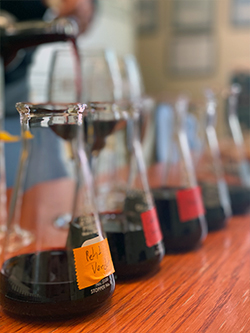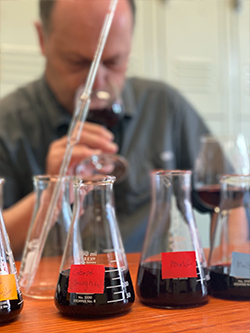Blending Trials: How Blends Are Made

From the outside looking in, winemaking is a glamorous profession filled with days spent drinking wine, nibbling cheese, and wandering the vineyards. And while we do do all of that sometimes, the majority of a winemaker's time is spent doing the hard work. As our winemaker Russell is so fond of saying, "Winemaking is 70% sanitation, 20% perspiration (doing the sanitation), 9% inspiration, and 1% degustation but only at the end of the day!" However the exception to that is blending season!
At Suhru, one of our favorite activities (and not just because we get to sit and taste) are blending trials, which are the fascinating and often painstaking process of selecting the best expression of a wine in that particular vintage.
When you are making a blend, be it red or white, you have two main courses of action. You can either make a field blend or a traditional blend. Field blends are made up of two or more types of grapes planted alongside each other in the vineyard, brought in together at harvest, and co-fermented in the winery. The other method— which we employ at Suhru—is to make a traditional blend, harvesting, fermenting, and barrel aging each of the varietals individually allowing each to develop independently before bringing the flavors together.
Each Spring—typically in April and May—we blend our reds. The main blend that tends to take the majority of our focus is Ember, our Bordeaux style red blend. Once our winemaker has deemed the individual varietals ready, he puts together a series of blends for us as a group to blind taste. After collecting barrel samples of each of the wines—Merlot, Cabernet Franc, Cabernet Sauvignon, Malbec, and Petit Verdot—he pours them into labeled beakers and assesses them each individually for their strengths and weaknesses. It is these strengths and weaknesses that determine how the wines will be blended together. For example, if we had an early winter then the later ripening reds (think Petit Verdot) may not have developed as fully so may not have as much tannic structure in which case we will lean more heavily on the early ripening varietals (think Merlot and Malbec), and barrel influence.

Once the wines have been assessed individually, Russell measures out samples of each variety into a graduated cylinder using a pipette. By doing this he is meticulously selecting the amount of each varietal as he blends them together into a series of different blends (typically 4-5) that best showcase the different directions we can take the wine. Of these 4-5 blends he typically makes one that he feels is the best overall expression, one that mimics as closely as possible the previous vintage and then 2-3 that fall in between those two starting points.
After all that work (by Russell) comes the fun part! We all get together and taste the blends blind so that none of us knows which wines are which. As we taste we discuss each blend, pointing out the strengths and weaknesses, what we like and dislike, providing feedback that Russell will take back to the winery with him to fine tune the blends. This is our opportunity to give any and all feedback and leave our thumbprint on the wines. We repeat this blending and tasting process as many times as necessary until we find the one that we all love and best represents the vintage, our style, and the individual varieties in the wine!
While of course important work, this is one of our favorite decisions to make and is a great way for us as a winemaking family to come together to share ideas, opinions, and shape the next vintage of Suhru Wines!
